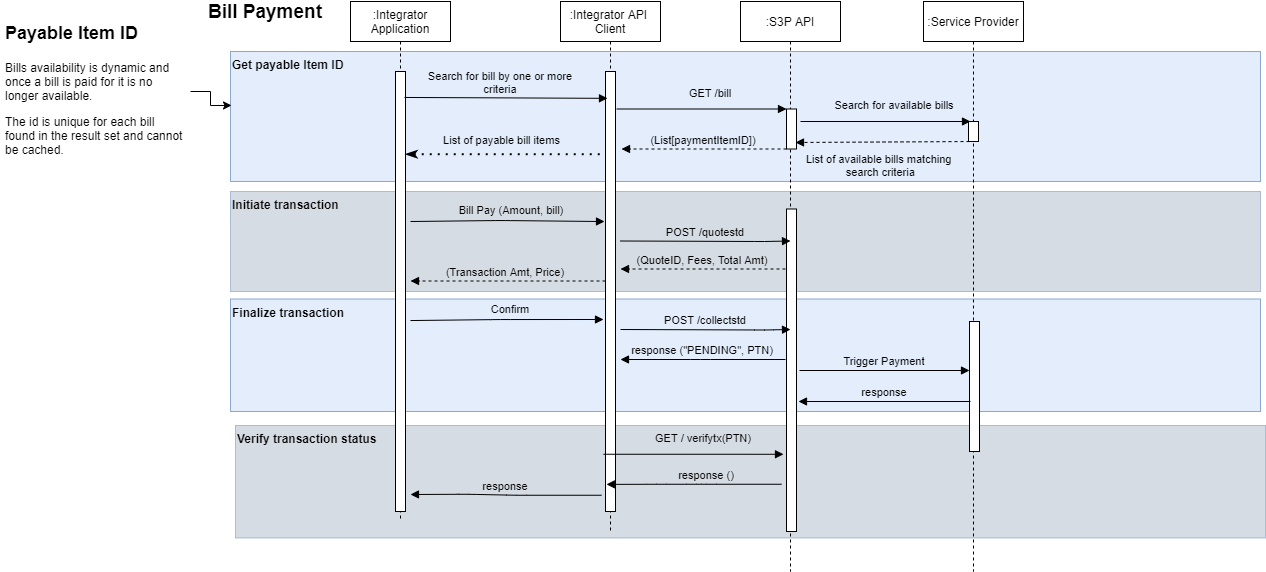Bill Payment Transaction
Bill Payment Types
Transactions of this kind represent individual outstanding payment claims based on a bill or invoice. Smobilpay supports two types of bill services.
SEARCHABLE: Bills of this type can be searched for by their respective service number. The endpoint will return detailed information about each bill found or an error if no bills could be found in the system.
Example:
A customer receives an invoice of 100 USD for his meter number with UTILITY-X.
Smobilpay offers UTILITY-X bills as a SEARCHABLE service.
Via the API, the agent can retrieve all bills for the meter number and the exact bill to be paid can be selected. Details on the bill can be displayed to the customer (for verification purposes) before the payment.
NON-SEARCHABLE: Bills of this type can be paid but individual bills cannot be searched. The bill collection information is directly sent to the bill provider. A customer needs to provide the service number with his bill service provider (e.g. bill number, meter number, service number, contract number, etc) and the amount to be paid.
Example:
A customer receives an invoice of 100 USD for his meter number with UTILITY-Y.
Smobilpay offers UTILITY-Y bill payments as a NON-SEARCHABLE service.
The customer provides his meter number with UTILITY-Y and pays an amount of 100 USD to the meter number.
High Level Transaction Flow
You can pay for a bill by following four easy steps:
Get a payable item ID for the service provider by calling the /bill endpoint
Initiate the transaction by calling the /quotestd endpoint
Finalize the transaction by calling the /collectstd endpoint
Verify the transaction status by calling the /verifytx endpoint

Advanced concepts in Bill Payment
Handling Bill Payment Order
Some service providers may required that bills MUST be paid in a particular order. This is reflected in the system by an order number starting at "1". The bill in a result set with the lowest number has to be paid first.
In case a bill provider does not require an order, all bills have the payment order "0".
Example - Bills with payment order
A customer has the following bills with a service provider: The bill provider requires bills to be paid chronologically
Bill Number | Bill Date |
XYZ 100 | JANUARY |
XYZ 101 | FEBRUARY |
XYZ 102 | MARCH |
The result set of a search shall provide a payment order in that case: payment order:
Bill Number | Payment Order |
XYZ 100 | 1 |
XYZ 101 | 2 |
XYZ 102 | 3 |
Example - Bills with NO payment order
The bill provider does not impose an order of bill payments.
Bill Number | Payment Order |
XYZ 100 | 0 |
XYZ 101 | 0 |
XYZ 102 | 0 |
Handling Payments for overdue bill
Some bill providers may mark bills as being overdue (payment due dead. They may also apply a penalty charge to any bill that is paid late by the customer. These charges are already included in the service amount of a bill. In addition the API will provide the exact amount that is charged as a penalty fee in an extra field. Each bill has a bill type that identifies it as either REGULAR bill or OVERDUE bill.
Example: A customer has the following bills with a service provider: For late payments a penalty of 50 is charged
Bill Number | Type | Bill Amount | Penalty Fee | Service Amount |
XYZ 100 | OVERDUE OVERDUE | 100 | 50 | 150 |
XYZ 101 | OVERDUE OVERDUE | 150 | 50 | 200 |
XYZ 102 | OVERDUE OVERDUE | 250 | 50 | 300 |
XYZ 103 | OVERDUE OVERDUE | 200 | 0 | 200 |
XYZ 104 | REGULAR | 300 | 0 | 300 |
XYZ 105 | REGULAR | 400 | 0 | 400 |
